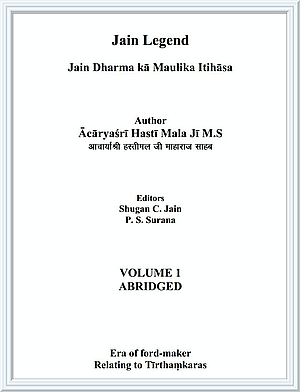After Lord Munisuvratanātha, Lord Naminātha was the 21stTīrthaṃkara. In his past life he was the king Siddhārtha of Kauśāmbī city in the western Videha province. On account of some factors he became disenchanted in worldly affairs. At the same time monk Sudarśana arrived, from whom he took initiation and observed special form of penance and restraint and obtained the Tīrthaṃkara nāmakarma. In the end, with a good feeling upon the end of his time span he became a god in the heaven named Aparājita.
After completing his years as a god, king Siddhārtha's soul left heaven and entered the womb of Viprā, the queen of the king Vijaya of Mithilā, on the full moon of the bright fortnight of Śrāvaṇa month under Aśvinī constellation. Queen Viprā saw the 14 auspicious dreams and started to protect the womb with appropriate food, relaxation, and conduct. On completion of the time the mother gave birth to a son of golden hue on the 8th day of the dark fortnight of the Śrāvaṇa month under Aśvinī constellation. On the day of the naming ceremony the king told people that when the boy was in his mother's womb enemies had surrounded Mithilā. Mother Viprā cast a kind glance at the enemies from the terrace which transformed the heart of the enemy kings and they prostrated at my feet. This was the effect of the boy in the womb; hence it would be apt to name the child Naminātha.
When Naminātha became a young man his father got him married to suitable princesses and when he was two thousand five hundred years old, prince Nami's coronation as king was held with great respect. Naminātha ruled for five thousand years and then, thought of being initiated. Lokāntikagods requested Naminātha to establish the tīrthas.
After a year of gift giving, king Naminātha handed over his kingdom to prince Suprabha, and with one thousand princes proceeded to Sahasrāmravana for initiation. Reaching there, observing the fast of chaṭhabhakta, duly renouncing all the bad deeds, accepted initiation on the ninth day of the dark fortnight of Āṣāḍha month. The next day, wandering, the Lord went to Vīrapura where he broke his fast at the house of king Datta, with rice pudding. To enhance the glory of the giving, the gods showered blessings of the five auspicious things. After being initiated Lord Naminātha wandered, while observing different kinds of penance as a mendicant, and then in the same garden under the Boraṣalī tree, entered into a meditative state. There, on the 11th day of the dark fortnight of Mṛgaśira in the fire of deep meditation, he burnt all the ghātikarmas and obtaining kevaladarśana and pure knowledge, became known as bhāva Arihanta. As a kevalī he gave a religious sermon to a huge gathering of gods and humans and, establishing the four-fold order, became a Tīrthaṃkara.
His congregation had 17 gaṇas and 17 Gaṇadharas, 1600 omniscient, 1207 telepaths, 1600 clairvoyants, 450 fourteen-pūrvadhārīs, 5000 vaikriya labdhidhārīs, 1000 vadis, 20000 monks, 41000 female-monks, 170000 votaries and 348000 female votaries.
After nine months less than 2500 thousand years as a kevalī, giving religious discourse, the Lord, with one thousand monks, went to Sammeta śikhara and started a fast. After a month, in the end, in the last stage of deep meditation, stopping the influx of activities, on the tenth day of the dark fortnight of Vaiśākha under the Aśvinī constellation, destroying all karmas, the Lord became omniscient and free. He was ten thousand years old.
Six lakh years after Lord Munisuvratanātha, Lord Naminātha attained liberation. The Tīrthaṃkara Naminātha and Namirājarṣi of Mithilā are not one and the same but different. Because of the name and the city some writers consider them to be the same.
 Acharya Hasti Mala
Acharya Hasti Mala
